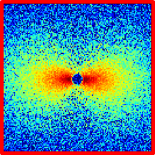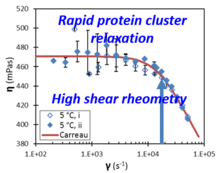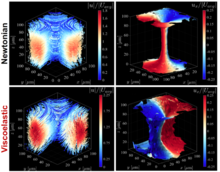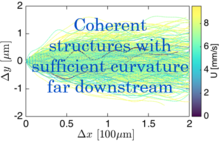Steven D. Hudson (Fed)
Physical Scientist

Research Interests:
Rheology, Microscopy, Scattering, Microfluidics
Research Opportunities:
National Research Council Fellowships
- Microfluidics for characterization of complex fluids, including rheoSANS, rheoSAXS
- Viscoelastic flow instabilities and turbulence
- Protein aggregation
- Mechanical Behavior of Organ-on-Chip
- colloid rheology of shaped particles
Fluid Suspensions and Emulsions project leader:
In the Fluid Suspensions and Emulsions Project, we are developing rheological measurement and data analysis methods to help take colloidal rheology beyond uniformly charged spheres to particles with more complex interactions.
Small Volume Rheology

The synergistic combination of morphology and rheology is instrumental for exploiting complex fluids, and is fundamental to polymer and colloid science. The Polymers and Complex Fluids Group is therefore developing methods to advance these measurement sciences. I am interested particularly in colloids, proteins, surfactants, interfacial phenomena and structure development. Through microfluidic device design, we (in the Fluid Suspensions and Emulsions project) control flow (type and strength) and measure fluid properties, aided by microscopic observations. Several collaborations are active. This work in large part is motivated by Protein Rheology.
Particle Tracking

Particle tracking is an essential aspect of our flow metrology research. Most importantly, this analysis determines when flow is suitable for measurement of fluid viscosity and steady-state structure, or when conversely flow instabilities occur at high shear rates encountered during manufacturing and use. Among the particle tracking methods used, holographic microscopy has exceptional temporal and spatial dynamic range. Our microscope can resolve particle position to 10s of nm over a depth of field of 200 um, and flow velocities (from 0.001 to 50) mm/s.
Using these features, we have compared with flow calibration (Experiments in Fluids 2017) and tested viscoelastic flow. When fluids are viscoelastic (such as polymer solutions), normal stress differences can cause flow instability, and even turbulent flow, at negligible Reynolds number, especially when the flow has curved streamlines. We have reported in collaboration with Paulo Arratia (UPenn) studies of:

- Spatial instabilities of flow in rectangular channels (Physics of Fluids 2017) and cross-slot geometry (submitted to Soft Matter)
- Temporal instabilities of flow through a constriction (Soft Matter 2018), around an obstacle (Journal of Fluid Mechanics 2019) or in cross-slot.
- Self-sustaining mechanisms of turbulence (Physical Review Letters 2019)
Scattering
With Katie Weigandt and others at the NCNR, we are developing new rheology instruments for neutron beamlines. µRheoSANS uses capillary rheology and a data analysis method to obtain the viscosity and scattering from the near wall region of the capillary or slit flow cell. This is found to agree with traditional Couette RheoSANS (Rheologica Acta 2018).
Protein particles
Globular proteins in solution adsorb to solid, liquid and air surfaces. These surfaces are sometimes a pathway to aggregation, and this instability must be prevented. We report a relationship between adsorption and particle formation (Molecular Pharmaceutics 2018 and 2020).
Other work:
Previous work includes:

- Microfluidic measurements of emulsion interfaces (Lab on a Chip 2006)
- Normal force measurements of shear thickening behavior (Physical Review Letters 2016)
- Orientation mapping of liquid crystalline polymers (Advanced Functional Materials 2010)
- Preparation and characterization of colloidal particles with patchy surfaces or non-spherical shape (Langmuir 2008)
Recent Invited Presentations
"Particle tracking and scattering to aide rheology, especially at high shear rates," 15th Annual Tiger-Hen-Hawk-Black Knight Rheology Symposium, 2020
"Neutron scattering and particle tracking to measure polymer solution rheology at high shear rates," FAMU-FSU, Chemical and Biomedical Engineering, September 14, 2018
"Suspension rheoSANS," Kavli Institute for Theoretical Physics conference, Non-linear Mechanics and Rheology of Dense Suspensions: Nanoscale Structure to Macroscopic Behavior, January 25, 2018
"Capillary and Slit Rheometry," Georgetown University, Physics, August 26, 2017
"High shear rate rheometry for in-situ neutron scattering," Rice University, Materials Science & Engineering, symposium in honor of Edwin Thomas, June 16, 2017
"Suspension rheology and new rheometers," University of Kansas, Chemical Engineering, December 8, 2015
Former Associates:
- Prof. Joao Cabral, Imperial College, London
- Dr. Thuy Chastek
- Prof. Gordon Christopher, Mechanical Engineering, Texas Tech
- Dr. Adrian Defante, Hollister Inc.
- Vishnu Dharmaraj, University of Chicago
- Prof. Kendra Erk, Materials Engineering, Purdue University
- Dr. Hua Hu, Procter & Gamble
- Dr. Cavan Kalonia, Astra-Zeneca
- Dr. Lucas Landherr, Chemical Engineering, Northeastern University
- Prof. Joie Marhefka, Penn State University, New Kensington
- Dr. Jeffrey Martin, Johnson & Johnson
- Dr. Jai Pathak, Astra-Zeneca
- Dr. Joel Rovner
- Dr. John Royer, Physics, University of Edinburgh
- Dr. Prasad Sarangapani, Regeneron Pharmaceuticals
- Dr. Jonathan Schwalbe, Johns Hopkins Applied Physics Laboratory
- Dr. Paul Start, Intel
- Dr. Philip Stone, USTC
- Prof. Juan Taboas, Dentistry, University of Pittsburgh
- Prof. Javen Weston, Chemical Engineering, University of Tulsa
Awards
- Fellow, Society of Rheology, 2023
For the development of innovative methodology and metrology solving important problems in soft matter and rheology for liquid crystals, emulsions, polymer blends and dense suspensions. - US Department of Commerce, Bronze medal, 2022
For development of innovative technology to probe simultaneously the structure and the rheology of complex fluids under extreme shear. - US Department of Commerce, Bronze medal, 2012
For leading the development of microfluidic methods to measure complex fluids. - Fellow, American Physical Society, 2006
For excellence in structural studies of supramolecular and polymeric materials and the quantitative description of droplet and particle dispersion under quiescent and flow conditions. - Glennan Fellowship, Case Western Reserve University, 1997-1998
- General Electric Scholarship, University of Massachusetts, 1985-1986.
- McMullen Scholarship, Cornell University, 1981-1983.

